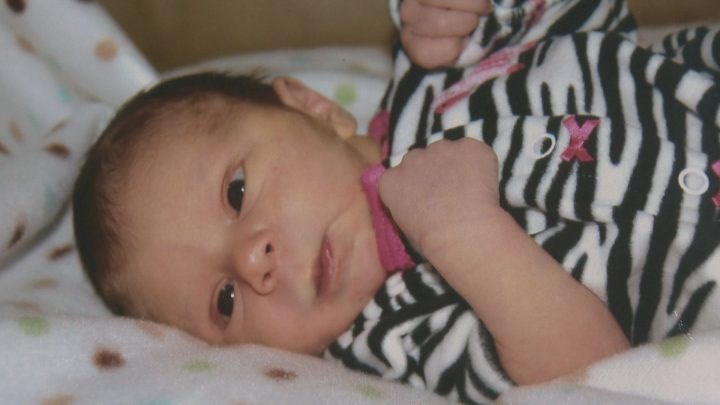This is the first story in ‘Unvaccinated: Canada’s Public Health at Risk,' a four-part Global News series on the challenge Canada faces from dropping vaccination rates.
Harper Whitehead was just seven days old when her mother noticed something was wrong.
“She had a little bit of a cough and her feedings were starting to decrease,” recalls Harper’s mother, Jessica Whitehead.
The Whiteheads had been living with Jessica’s parents in the rural community of Picture Butte, Alta., a small, farming town just north of Lethbridge. In 2012, about 1,700 people called the town home. The crime rate was low and people knew their neighbours. Whitehead never imagined her baby daughter would be in danger there.
“It was day 10 that she actually went into the hospital. She was instantly admitted and hooked up to oxygen and by the end of day, she was airlifted to the (Alberta) Children’s Hospital in Calgary.”
Harper had whooping cough, also known as pertussis. It’s a vaccine-preventable illness that for infants is often deadly. In Alberta, children can’t be vaccinated against pertussis until they are two months old, so Harper was completely vulnerable to the infection.
She also happened to be living in a community where immunization levels were so low that there was no herd-immunity protection available for her. Herd-immunity protection happens when enough of a population is immunized against a disease for those unable to be immunized (like a newborn infant) to be protected. For a disease like pertussis, a 94 per cent immunization rate is required.
“To watch it take over a little body is very surreal. You don’t want to believe it’s as serious it is,” Whitehead said.
“I just remember knowing that I was going to lose her, that whooping cough was going to win this one, and I just wanted to hold my daughter as she passed.”
A horseshoe-shaped area around Lethbridge, Alta. has seen 12 different outbreaks of vaccine-preventable diseases. They include a rubella outbreak in 1996; measles outbreaks in 1997, 1999, 2013; a mumps outbreak in 2017; and six outbreaks of pertussis/whooping cough between 1999 and 2017.
“In southern Alberta, immunization uptake between children varies between communities and schools. We have some schools with 10 per cent of children immunized, and others with 90 per cent,” said Dr. Vivian Suttorp, medical officer of health for Alberta Health Services south zone.
Dr. Suttorp says the reasons why immunization rates are low in the region are complex. Religious and cultural beliefs play a role, but across Canada, this community is not unique. Health officials have identified a number of other places across the country that are vulnerable to outbreaks because they are largely unprotected.
According to Alberta Health Services, those communities include Norwich (Oxford County), St. Catharines and Brantford in Ontario; the Lower Fraser Valley, Smithers and Vanderhoof in B.C.; and the Lacombe, Rimbey, Red Deer and Lethbridge-areas in Alberta.
“I think a big part of public health is surveillance, looking at data,” Dr. Suttorp said. “Where are the diseases in the world? Where are diseases in Canada? What are our immunization rates?”
The problem is that across the country, the picture is incomplete. Immunization tracking falls under the jurisdiction of Canada’s provinces and territories and there are no national standards in place.
“For public health purposes, definitely more work needs to be done in order for us to tell where the pockets of immunization are,” said Dr. Theresa Tam, Canada’s chief public health officer.
“I am concerned because if we don’t improve our vaccination rates and if there is chance that this can slip, we’ll see an increasing emergence of diseases that were once disappearing in Canada.”
Seven years after losing her daughter, Whitehead says it’s difficult to hear about anyone choosing not to vaccinate their children and she fears for other families who may be put at risk.
“I can see the things that Harper could be doing and should be doing and would be doing and how big she would be today … but I don’t get to experience that with my own daughter. It’s really hard.”
- Global News



